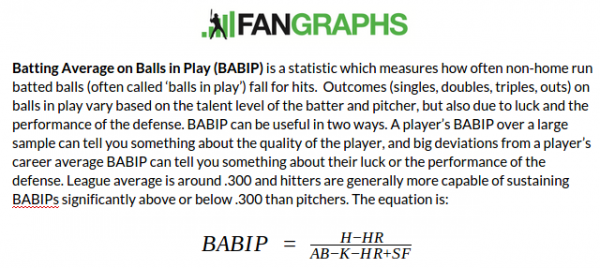The metric “Batting Average of Balls In Play”, commonly known as BABIP, can be a complicated metric to understand. That is especially true from a fantasy baseball perspective.
The definition of BABIP can be found on Fangraphs, as it was updated on February 10th, 2010 by Piper Slowinski. Here’s what the definition states (along with some context on BABIP):

The common “groupthink” among fantasy baseball players, fans, and analysts when it comes to BABIP pertaining to hitters typically gravitates toward these two perspectives:
- If they have a BABIP way above that .300 mark, they are due for some regression eventually, especially if the breakout is coming out of nowhere.
- If they have a BABIP way below the .300 mark, they are due to improve eventually, especially if they have demonstrated production at the plate in the past.
But of course, it’s not always that simple.
That is especially true with 15 hitters who were highly targeted in fantasy drafts (especially deep formats) but are off to slow starts which appear to be “BABIP-influenced” (i.e. they are suffering from low BABIP numbers).
Here is a list of those low-BABIP hitters and a table containing what team they are playing for as well as their BABIP and wOBA marks so far through April 18th.
Granted, some of these batters on this list may only be rostered in deep leagues or draft-and-hold formats (especially hitters like Carlos Santana and Tommy Pham). However, a number of hitters on this list were going in the first round of many drafts or commanding a lot in salary cap draft formats.
While we know the struggles of these hitters can be tied to their low BABIP marks, what is necessarily fueling their slow starts varies among the group of 15.
Which ones are hitting the ball hard and just getting unlucky?
And which ones are showing signs of concern, whether it is in their contact or batted ball or plate discipline?
(All data through April 18th)
BABIP and Batted Ball Quality
Through a Fangraphs custom report, I decided to hone in on these 15 hitters and decided to look at three different kinds of metrics to come to conclusions about the low BABIP marks for each hitter on this list.
Here are the three statistical categories:
- Batted Ball Quality (LD/FB/GB rates; Soft/Medium/Hard contact; etc.)
- Plate Discipline (Swing percentages; Strike percentages)
- Statcast Data (Exit Velocity; Launch Angle; Barrel Rates)
So, let’s focus on batted ball quality first.
I honed in on this because how a hitter is hitting the ball could explain why a hitters’ BABIP numbers are suffering during a tough stretch at the plate.
Are they hitting line drives and making hard contact? Or are they hitting a lot of infield fly balls and softly hitting the ball, which won’t lead to a lot of hits.
In the table below, I organized the hitters from lowest BABIP to highest and also added line drive rate (LD%), groundball rate (GB%), flyball rate (FB%), and infield flyball rate (IFFB%).
Three hitters had IFFB rates over 20% (Merrifield, Santana, and Goldschmidt). While Goldschmidt and Santana had line drive rates of 13%, Merrifield on the other hand had a line drive rate of 30%, which was the highest mark in that category of the 15 hitters listed.
Some hitters still had high flyball percentages, with four hitters having FB rates of 50% or over (Tucker, Schoop, Semien, and Sanó). Sanó and Tucker had sub-.100 BABIP marks and Schoop and Semien had .143 and .161 marks, respectively. All four hitters have 20 to 30-plus home run potential, and it would be interesting to see if their BABIP numbers will increase once the weather becomes warmer (Schoop and Sanó play primarily in upper Midwestern cold-weather cities).
The ones with high line drive rates would be hitters to keep the faith in when it comes to a turnaround. Altuve, García, Correa, and Merrifield all had line drive rates of 25 percent or higher. Considering that line drives are more likely to drop for hits than groundballs or flyballs, these four hitters could see a turnaround as long as they maintain those strong line drive percentages going forward.
BABIP and Plate Discipline
The next thing I wanted to take a look at was plate discipline. Which hitters were showing patient approaches and which ones from this list were more free-swinging?
That could give a glimpse into which hitters were swinging at pitches that could be driven consistently for base hits, and which ones were swinging at pitches that would produce a low probability of making “productive” contact.
In the table below, I added the categories of chase rate (O-swing %), swing rate (Swing %), and contact percentage (Contact %).
The hitters that should stick out are ones who have high O-Swing percentages and low contact rates.
Those batters who swing out of the strike zone 30% or more out of the strike zone, and those with sub-70% contact rates should be tagged with red flags (and there are plenty with that profile from this list).
A big reason for that awareness is that pitches outside of the strike zone often aren’t pitches that can be hit for quality contact. Second, hitters with lower contact rates put the ball in play less. Fewer balls in play mean fewer opportunities for balls to fall for hits, which thus suppresses BABIP numbers and affects hitters’ overall lines.
Therefore, fantasy managers should be cautious of hitters like Correa, Rodgers, and García, especially if they continue with such low contact rates. Sanó is a concern too due to the low contact rate (64.9 percent; lowest of the bunch). That being said, he has a low swing rate, and he profiles as a “feast-or-famine” hitter. That will typically suppress his BABIP anyways, but fantasy managers are employing Sanó for home runs and not much else.
BABIP and Statcast Data
The last collection of data I took a look at it and compared to BABIP was Statcast data, which are metrics that can be commonly found on Baseball Savant and Pitcher List percentile sliders. I created a table that contained relevant Statcast data: average exit velocity, launch angle, and barrel rate data.
Here’s the table containing the data on EV, LA, and barrel rate and how it correlates to BABIP:
Now, some hitters are going to rate naturally low in these three major categories.
For example, Merrifield has traditionally rated low in these three categories, but he makes such high contact, which helps him recover in BABIP quickly. Also, a lot of his fantasy value comes from steals. So as long as Merrifield makes a high amount of contact (and his batted ball data suggests that he is), then he will be eventually fine despite how meager these three categories look.
Robert is another hitter who fantasy managers should feel confident about going forward, despite the low BABIP thus far. His average exit velocity is the second-highest mark of hitters on this list, and his barrel rate is the highest as well.
His average launch angle of 10 degrees does leave a bit to be desired. However, if he can make a slight adjustment and see an increase in that LA, it’s not out of the question that his BABIP will jump. That will put Robert in that top hitter category again, which he was pegged for at the beginning of the year.
The ones to worry about from this list are ones with either sub-90 MPH EV marks; 10 or lower launch angles; and sub-5% barrel rates, especially hitters who are tagged as “power” hitters.
Thus, hitters like Goldschmidt, Semien, and Schoop for example I would have some reservations about, though it will be interesting to see if they can improve in one of those categories in the next couple of weeks.
If they do, they will be back on the right track.
If not, not only will the BABIP fail to rise significantly, but their overall production outlook for 2022 could be in trouble as well, making them a drain on fantasy teams who depend on them for production.
Final Thoughts On BABIP
As one can see from the data above, BABIP is complicated.
One cannot just look at BABIP and say “Oh, it’s a bad stretch, they’ll be better soon” as a foregone conclusion. It’s also important to look at the batted ball, plate discipline, and Statcast data to understand the root of the BABIP problem for a particular hitter.
Right now, of the list of 15 hitters who are struggling with BABIP issues, there are some who seem like they will be fine once they get some better-batted ball luck. Robert, Tucker, Schoop, and surprisingly Santana are ones that primarily stick out (though Santana will constantly suffer due to frequent shifts, especially when he’s batting from the left side).
On the other hand, there are some hitters whom fantasy managers should have concerns about, especially Rodgers, García, and Correa.
The first two are probably more deep-league hitters. However, Correa has widely been a top selection in leagues. Even though he had a strong performance on Monday against the Red Sox, his lackluster contact and flyball rates, as well as launch angle, could make BABIP regression not necessarily a “sure thing”, especially in the near future.
This is just a small sample size, and fantasy managers may see spikes in these hitters’ BABIPs this week, which will make this list of players and all this data irrelevant.
That being said, when looking at hitters going through tough stretches, fantasy managers and even curious baseball fans should not just look at the BABIP solely.
Those other metrics and how they relate to BABIP are just as important when it comes to identifying struggling hitters and how they will snap out of their respective slumps.
Photos by Icon Sportswire | Adapted by Justin Redler (@reldernitsuj on Twitter)


As an owner of many shares of Whit Merrifield, this was by far the most helpful anything I’ve read or heard this season…even if the actual result was somewhat mixed. Thanks!
No problem Scott! As a Royals fan, I’m hoping for a Whit turnaround as well. He’s such an interesting case because of his high line drive rate, but also high IFFB rate, so it’ll be interesting to see if things stabilize, and what kind of effect it’ll have on his overall line as he gets more at-bats.